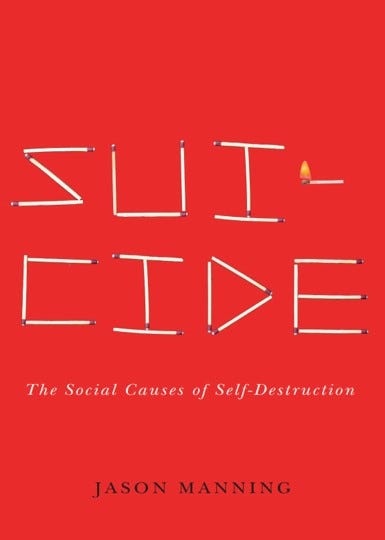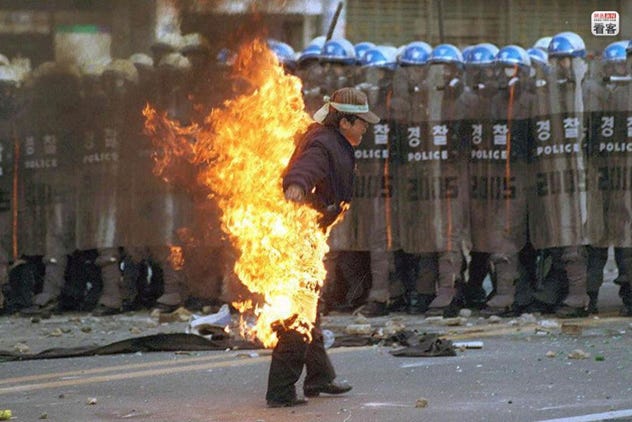Social Causes and Consequences of Suicide
No man is an island.
I’ve been in South Korea this month, giving presentations at Kyungpook National University in Daegu and Ulsan National Institute of Science and Technology in Ulsan. This post is based on those presentations, being a shortened and polished version of my notes.
Reminder that you can support Bullfish Hole by subscribing and/or by leaving a donation of any size in the Tip Jar.
Introduction
Thank you for hosting me. I am quite grateful for the opportunity to speak here today.
The topic of my talk is suicide. Defined broadly, this is any kind of lethal violence inflicted on the self. This includes fatalities as well as nonfatal attempts.
Suicide is a topic of great importance, and one that touches many lives. In the US, for instance, the suicide rate increased substantially in between 2011 and 2020, going from about 10 per 100,000 to 14 per 100,000. Individual regions, especially rural areas, saw even larger and faster increases. Even with recent increases in the crime rate, far more Americans die by suicide than by murder.
Suicide is even more common in Korea, where suicide rates have for decades been two to three times the US rate. Korean suicide rates surged from 13 per 100,000 in the year 2000 to a high of 32 per 100,000 in 2011. They are now somewhat lower than this peak, hovering around 26 per 100,000. This gives Korea that highest suicide rate among the developed nations.
It’s only natural then, that we would want to explain why suicide happens, and why it happens more in some times and places than in others.
Approaches to Suicide
There are several different ways we could approach the topic. Here I distinguish four pure types of approach.
In the biological approach, people understand and explain suicide as function or dysfunction of the human organism. Is it the result of inflammation? Of a shortage of the neurotransmitter serotonin? Of a nutrient deficiency?
In a purely psychological approach, one focuses on the working of the mind, such as emotions, perceptions, or other mental states leading to suicide. Do people do it because they are sad? Because they are hopeless? Because they think badly of themselves or feel a burden on others?
The dominant approach to suicide these days is psychiatric. The psychiatric approach treats suicide with a medical model, as a symptom of illness such as clinical depression. This approach might draw from all the others — in the West, at least, it predominately draws from the biological and psychological. Thus depression is treated with chemical antidepressants meant to alter the brain, but also with cognitive behavioral therapy meant to change habits of thinking.
I do not believe these approaches are wrong or fruitless — if the therapy works for you, continue — but I do believe them incomplete. For suicide is also shaped by the individual’s social situation, and suicide rates rise and fall with social changes. Yet such factors are often left by the wayside in popular and policy discussions that rely on the mental model.
To correct this, I wrote a book called Suicide: The Social Causes of Self-Destruction. The book summarizes a lot of published work, and adds a few ideas of my own, to try to outline the main social factors that affect suicide. In this talk I also plan to say a little about the consequences of suicide, which is the topic of a book project I’m working on with sociologist James Tucker.
But before I get into all that, I want to emphasize that suicide, while often thought of as a purely individual behavior, is often a social behavior in its own right. It’s often social action by extreme means and must be understood in its social context.
Suicide as Social Behavior
Suicide can be an act of escape. Indeed, there is probably an element of this in the large majority of suicides. Sometimes it is escape from general suffering, whether physical or mental. It is self-inflicted mercy killing.
But suicide can also be a way of escaping from particular enemies. Africans captured for slavery in the Americas often killed themselves rather than submit to bondage. A belief arose among some of them that if they hanged themselves next to bundles of their worldly goods, they would be resurrected in their homelands. Their deaths were a kind of supernatural flight.
But sometimes suicide is much more than just escape. Sometimes it is a way of protesting or punishing wrongdoing. It is a way of expressing grievances and seeking justice.
Many of you are familiar with the idea of protestors setting themselves on fire. Death by burning, popularly called “self-immolation,” has become a recognized part of the repertoire of protestors around the world. For example in 1963 in Vietnam, a Buddhist monk set himself on fire at a busy Saigon intersection to protest the government’s suppression of Buddhism. Many of you are also probably familiar with the protest suicides of democracy and labor activists in Korea. For instance, there’s the famous suicide of Korean labor activist Jeon Tae-Il in 1970, who burned himself in support of worker’s rights. Other cases have happened since, including among auto workers in Ulsan in the 1990s.
It's worth noting that protest suicide doesn’t just happen in big public conflicts. Even in private relationships, people might turn to attempted suicide as a way to appeal to another person to change their conduct or provide help. Interviews with people who survive attempts reveal that this is a major reason many people commit the act.
Sometimes it is less a matter of protest than of punishment. For example, someone who wants another person to feel guilt and remorse for hurting him. Or sometimes it’s even a matter of people punishing themselves.
In several times and places throughout history, suicide has been a kind of capital punishment. The rulers will order offenders to kill themselves, and they will carry out the sentence. You see this in the famous case of Socrates, who drank hemlock after the authorities in Athens sentenced him to. In Japan during the Tokugawa period, samurai warriors would execute themselves for failures of duty. You see similar patterns in ancient Rome and dynastic China, among other places.
I came to the study of suicide by way of researching conflict, so a lot of my work focuses on suicides that are a matter of protest or punishment. But other suicides are aimed at helping people. They’re acts of altruism.






